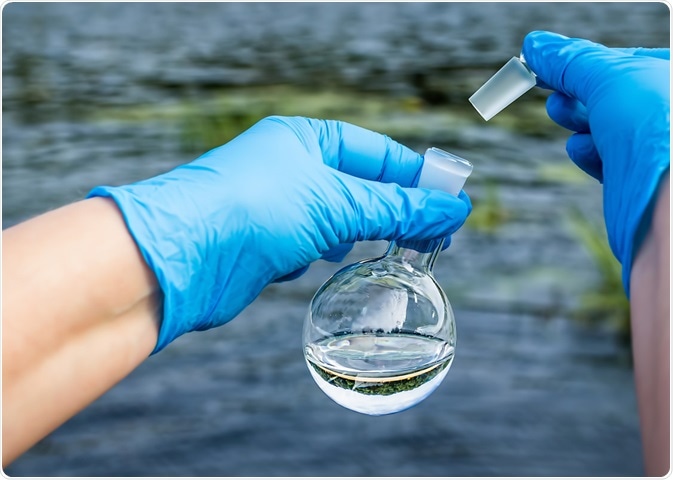A team from Zhejiang University has determined a way to detect pollutants present at low concentrations in drinking water.
 Image Credit: Mr_Mrs_Marcha / Shutterstock.com
Image Credit: Mr_Mrs_Marcha / Shutterstock.com
By using a combination of methods, morphological grayscale reconstruction method combined with alternating trilinear decomposition (ATLD) and a with a threshold method based on 3D fluorescence spectroscopy, the spectral signal-to-noise ratio of pollutants flagged in water were improved. This resulted in the identification of organic pollutants in drinking water, even when present at low concentrations.
Water quality detection is commonly assessed by a range of techniques, including gas chromatography (GC), high-performance liquid chromatography (HPLC), and gas chromatography-mass spectroscopy (GC/MS). However, they suffer the drawbacks of being complex, requiring a high time-demand and being poor detectors at low pollutant concentrations.
The concentration limit of most organic pollutants is less than 10 μg/L, which means both timely and precise discovery of pollutants is essential. Spectral analysis has become increasingly preferred as a detection method -- it avoids the need to extract samples and subject them to pre-treatments.
Namely, UV-Vis and fluorescence spectroscopy are implemented; UV-Vis offers sensitivity (within a boundary) and a suitably low detection limit, while 3D fluorescence microscopy can detect and analyze organic pollutants.
The sequence carried out when detecting organic pollutants in drinking water includes 3D fluorescence analysis, extraction, and the organic pollutants classification and identification. Earlier researchers have focussed on discriminating between pollutants, analyzing them quantitatively, and discovery and classification based on 3D fluorescence spectra. However, all have the potential to be improved.
In efforts to achieve this, Shi et al. introduced a morphological grayscale reconstruction method to pull characteristics of 3D fluorescence spectra. The morphological method is the most popular method used when conducting image analysis. This process involves changing the grayscale image into a binary image, which results in the designation of either a 0 or 1 to each pixel.
Each of the spectral peaks returned is viewed as a pixel, and through this, pollutants in drinking water can be characterized. Spectral features are located using this method, and the signal is amplified using an amplification factor.
Amplification is also crucial when conducting pollutants. Subsequent use of the alternating trilinear decomposition method (ATLD), another highly implemented fluorescence spectral feature is used to achieve this. It encompasses an extraction and modeling algorithm which is good at detecting high-concentration pollutants in drinking water.
The samples tested by Shi et al. were background drinking water samples, classified into four groups, and categorized according to the time and periodicity of extraction. These were further subdivided into pollutant concentrations (low, medium, and high). The team performed peak localization for each pollutant group at concentrations which were representative of their compositions; the characteristic peaks of normal drinking water were also removed.
From their results, Shi et al. determined that peak positions unique to each of the pollutants could be collected when applying the morphological grayscale reconstruction method. This method was also used to determine further features and amplify the signal of the pollutant. The team achieved better extraction by using an altered ATLD method. For a tested pollutant, rhodamine B (4 μg/L), the signal-to-noise ratio of the spectra, as well as the detection efficiency of pollutants, were improved.
On its own, ATLD is a poor detection method for low-concentration pollutants; the accuracy of detection falls further still when the quality of the background water varies. However, when modifying the feature-extraction method to include morphology grayscale reconstruction, 3D fluorescence spectral peak characteristics can be concentrated and amplified.
This allows organic pollutant data to appear in the characteristic area. As a result, Shi et al. were able to identify abnormal samples and greatly improve low-concentration organic pollutant detection. Further, the threshold method – another popular peak identification method – was used to determine the quality of the drinking water
Shi et al. identified that one pollutant, phenol was virtually indistinguishable from drinking water due to a characteristic peak overlap. As such, the team notes that further studies are required to differentiate pollutants with peaks in common with drinking water present.
Acknowledgments
This research was funded by the National Natural Science Foundation of China, the National Key R&D Program of China, the Fundamental Research Funds for the Central Universities, Zhejiang Provincial Natural Science Foundation of China.
The authors declare no conflict of interest.
References
Shi, F. et al. Morphological Grayscale Reconstruction and ATLD for Recognition of Organic Pollutants in Drinking Water Based on Fluorescence Spectroscopy. MDPI. DOI: https://doi.org/10.3390/w11091859 (2019)
Further Reading
Last Updated: Dec 13, 2019